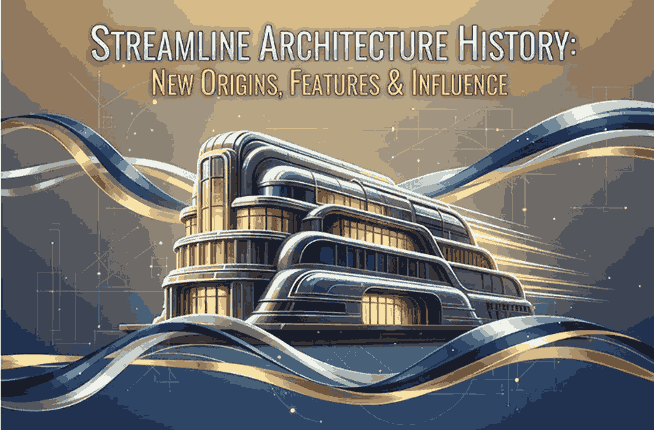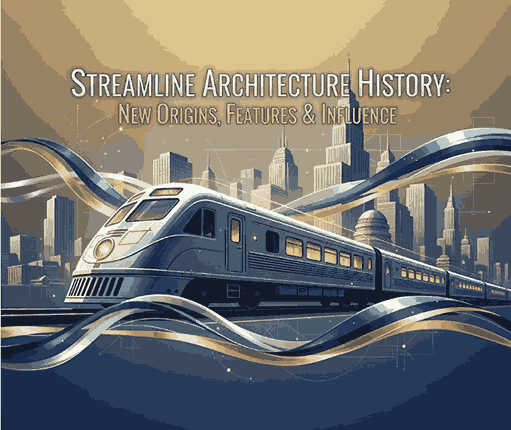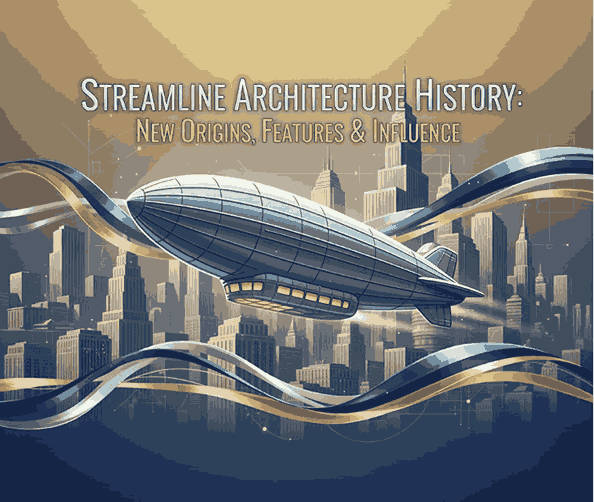
Table of Contents
- Introduction
- What Is Streamline Architecture?
- Historical Background: The Rise of the Streamline Era
- Key Characteristics of Streamline Architecture
- Influence of Industrial Design on Streamline Architecture
- Streamline in Modern Visual & Graphic Design
- Using Fonts to Illustrate Streamline Style in Design Projects
- Recommended Fonts for Streamline-Inspired Mockups
- Why Streamline Design Still Matters Today
- Conclusion
- References
1. Introduction
Streamline Architecture History — often called Streamline Moderne—is one of the most iconic design styles that emerged in the early 20th century. Recognized by its sleek forms, rounded edges, and aerodynamic aesthetics, this movement significantly shaped the design world. From buildings and transportation to graphic design and typography, Streamline’s influence continues to inspire modern creatives today.
This article explores the Streamline Architecture History, its core characteristics, and how designers can incorporate its visual philosophy into contemporary projects, including font usage.

2. What Is Streamline Architecture History?
Streamline architecture is a style that emphasizes smooth, flowing lines, curved forms, and a sense of movement. It was deeply inspired by machines and the aerodynamic principles seen in vehicles like trains, ships, and airplanes.
Unlike the sharp, geometric angles of Art Deco, Streamline Moderne softened the aesthetic to create more fluid and horizontal visuals.
3. Historical Background: The Rise of the Streamline Architecture History Era
The Streamline movement gained popularity during the 1930s and 1940s, particularly in the United States and parts of Europe. The Great Depression significantly influenced design sentiment—simplicity, efficiency, and functionality became priorities.
Many experts link the rise of this aesthetic to:
- Industrial mass production
- Advances in transportation technology
- The cultural fascination with speed and progress
Streamline architecture became a symbol of optimism and modernity, showing that even in difficult times, design could embody hope and innovation.
4. Key Characteristics of Streamline Architecture History
Streamline architecture is easily recognized through its unique features, including:
✓ Horizontal Emphasis
Horizontal lines dominate the façade, creating a sense of speed.
✓ Rounded Corners
Curved edges imitate aerodynamic surfaces, similar to vehicles.
✓ Long Bands of Windows
Often called “ribbon windows,” these add continuity and visual flow.
✓ Smooth, Polished Surfaces
Materials such as stucco, chrome, glass block, and metal were common.
✓ Nautical Influence
Many buildings feature ship-like elements such as porthole windows, metal railings, and deck-inspired terraces.
✓ Minimal Ornamentation
Unlike Art Deco, Streamline architecture avoids heavy decoration, focusing on form and function.
5. Influence of Industrial Design on Streamline Architecture History
Streamline architecture is inseparable from industrial design. During the Machine Age, designers focused on making products efficient, aerodynamic, and visually appealing. This industrial mindset carried over into architecture, shaping buildings to feel fast, futuristic, and functional.
The era also produced iconic streamlined products like radios, refrigerators, cars, and household items—all contributing to the overall aesthetic.
6. Streamline Architecture History in Modern Visual & Graphic Design
Today’s designers still draw inspiration from Streamline principles, especially in:
- Branding
- Logo design
- Editorial layout
- Typography
- Product packaging
The style’s clean geometry, sleek curves, and minimalism align with today’s modern design trends. Many brands use a streamlined visual identity to convey innovation, sophistication, and efficiency.
7. Using Fonts to Illustrate Streamline Architecture History Style in Design Projects
Fonts play a crucial role in interpreting Streamline architecture for digital and graphic design projects. Ideal choices include:
- Clean sans-serif fonts
- Geometric shapes
- Minimalist strokes
- Rounded edges
- Sleek modern lines
These qualities echo the smooth, futuristic, and aerodynamic character of the Streamline movement.
8. Recommended Fonts for Streamline Architecture History-Inspired Mockups
Below are font products from CalligraphyFonts.net that complement the Streamline aesthetic perfectly:
1. Holters Font
A clean, minimal sans-serif with modern geometry—perfect for sleek headings and display designs.
2. Dinernighty Font
A retro yet modern sans-serif with strong Streamline character. Its rounded structure mimics Machine Age styling.
3. True Private Font
A professional minimalist sans-serif ideal for architectural layouts, infographics, and posters.
4. Bluefine Modern Font
A sophisticated geometric font with clean strokes, perfect for creating elegant Streamline-style presentations.
Using these fonts will help designers visually translate the aerodynamic, futuristic spirit of the Streamline era into modern creative work.

9. Why Streamline Architecture History Design Still Matters Today
Even decades later, Streamline architecture remains relevant for several reasons:
• Timeless Modern Appeal Streamline Architecture History
Its clean lines and minimalist nature align with today’s design trends.
• Versatility Streamline Architecture History
The style fits various applications—architecture, branding, typography, and product design.
• Psychological Impact Streamline Architecture History
Smooth and aerodynamic visuals create feelings of efficiency, speed, and modernity.
• Inspiration for Futuristic Design
Many futuristic concepts borrow from Streamline’s curves and aerodynamic shapes.
The movement may have begun almost a century ago, but its influence continues to shape the design world today.
10. Conclusion
The history of Streamline architecture represents an important chapter in design evolution. From its industrial roots to its impact on modern aesthetics, this style remains a source of inspiration for contemporary designers. Whether you’re working on branding, editorial layouts, or digital visuals, incorporating Streamline principles—and using suitable fonts—can elevate your work with a sense of polished modernity.
The recommended fonts from CalligraphyFonts.net offer the perfect tools to bring Streamline-inspired concepts to life in your design projects.
11. References
- MoMA – Machine Age Design
- Ohio History – Architectural Findings on Art Moderne
- Academic article – Mechanization and Streamline Moderne
- Los Angeles Times – The Graceful Lines of Streamline Moderne
